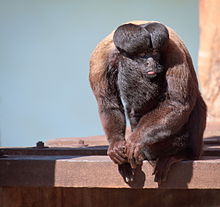Uta Hick's bearded saki
Appearance
| Uta Hick's bearded saki[1] | |
|---|---|

| |
| Scientific classification | |
| Domain: | Eukaryota |
| Kingdom: | Animalia |
| Phylum: | Chordata |
| Class: | Mammalia |
| Order: | Primates |
| Suborder: | Haplorhini |
| Infraorder: | Simiiformes |
| Family: | Pitheciidae |
| Genus: | Chiropotes |
| Species: | C. utahicki
|
| Binomial name | |
| Chiropotes utahicki Hershkovitz, 1985
| |

| |
| Uta Hick's bearded saki range | |
Uta Hick's bearded saki (Chiropotes utahicki) is an
Amazon between the Xingu and Tocantins Rivers.[1] It was formerly treated as a subspecies of the more easterly C. satanas, but its back is pale brownish.[3][4]
Etymology
It was named in honor of Uta Hick, a German primatologist who cared for bearded sakis at the
married name is Uta Rümpler.[8]
The
ICZN rules.[8][9] Even though -i technically indicates a male honoree, some sources discourage modifying the earlier utahicki,[10] because there is no official way to make such corrections under the current (1999) ICZN.[11]
References
Wikispecies has information related to Uta Hick’s Bearded Saki.
- ^ OCLC 62265494.
- .
- ^ Silva Jr., J. S. and Figueiredo, W. M. B. (2002). Revisão sistemática dos cuxiús, gênero Chiropotes Lesson, 1840 (Primates Pithecidae). Livro de Resumos do XO. Congresso da Sociedade Brasileira de Primatologia, Amazônia – A Última Fronteira: 21. Belém, Brazil.
- ^ Bonvicino, C. R., Boubli, J. P., Otazú, I. B., Almeida, F. C., Nascimento, F. F., Coura, J. R. and Seuánez, H. N. (2003). Morphologic, karyotypic, and molecular evidence of a new form of Chiropotes (primates, pitheciinae). American Journal of Primatology 61(3): 123-133.
- ^ Fieldiana: Zoology. Chicago Natural History Museum. 1985. p. 21.
named in honor of Fräulein Uta Hick, Curator of the Kölner Zoo and long-time editor of the prestigious Zeitschrift des Kölner Zoo. Much is owed Miss Hick for her contributions
- ISBN 978-1-107-35468-5.
that time, the only captive bearded sakis were held at the Cologne Zoo in Germany, under the care of pioneering primatologist Uta Hick. She was later recognized for her work by Philip Hershkovitz, when he named a new bearded saki Chiropotes satanas utahicki in 1985.
- ISBN 978-0-07-909508-4.
Bearded sakis have been satisfactorily kept only by Uta Hick of the Cologne Zoo. She reports her recipe for success: 'I would say from my experience that all sakis are extremely sensitive animals...'
- ^ a b Fieldiana: Zoology. Chicago Natural History Museum. 1993. p. 6.
Uta Hick (now Uta Ruempler) must take the feminine ending. It is herewith emended to Chiropotes satanas utahickae.
- ^ "Article 31". ICZN (4 ed.). 1999.
A species-group name, if a noun in the genitive case […] formed directly from a modern personal name, is to be formed by adding to the stem of that name -i if the personal name is that of a man, […] -ae if of a woman
- ^ Brandon-Jones, D., Duckworth, J. W., Jenkins, P. D., Rylands, A. B., and Sarmiento, E. E. (2007). The genitive of species-group scientific names formed from personal names. Zootaxa 1541: 41-48.
- ^ "Chiropotes utahickae". Integrated Taxonomic Information System. 2022.
originally given as utahicki, which SHOULD have been utahickae, but this does not appear to be a correctable error under the ICZN Art. 32.2 and 32.5. Use of -i instead of -ae appears to be an incorrect Latinization, which is not to be considered an inadvertent error (Art. 32.5.1), so the error is not one that 'must' be corrected, and it must be considered the 'correct original spelling.' In a discussion on the ICZN-List (March 2021) it was generally agreed that there is a problem for cases where a name was incorrectly formed/Latinized under Art. 31.1.2 (incorrect use of ending -i/-orum/-ae/-arum, according to the number & sex of honorees) of the 4th edition (1999) of the Code, in that the Article doesn't contain a corrective option, and the wording of Article 32 does not include this type of correction. This 'glitch' will be addressed in the next edition of the Code, but until this is resolved, ITIS will make note of these cases and try to follow current usage, where possible.

